This post has not been edited by the GamesBeat staff. Opinions by GamesBeat community writers do not necessarily reflect those of the staff.
Be sure to check out part 1 of my Metal Gear retrospective to find out about the original MSX2 version of the game and to find out why I'm writing this retrospective in the first place.
Last time I wrote about the original Metal Gear, the game that started it all. It was an ambitious MSX2 game which was released in Japan and Europe, and was well ahead of its time. Playing it now, you'll notice many of the similarities which it has with one of the later sequels, Metal Gear Solid, the game which got me into the franchise in the first place.

NES Version
But before I ran my MGS fansite, I was only aware of the MSX2 version, and its sequel, Metal Gear 2: Solid Snake. However, Metal Gear wasn't finished with the original. I discovered that, like a Lernaean Hydra, the series had many heads in the form of ports.
In the wake of the video game crash in the 80s, lots of different competitors released their own systems, and there wasn’t one dominant platform (or set of platforms) across all regions. Instead different systems ruled the roost depending on the region. This meant that many games by third parties had to be versatile: they needed to be able to be ported across multiple systems, most of which had vastly differing specs and abilities. As such, Metal Gear "enjoyed" ports to the NES, Commodore 64 and MS-DOS.
Looking back on Metal Gear, its ambition in pushing the MSX2 hardware to its limits was perhaps its biggest flaw.
Metal Gear (NES)
A subsidiary of Konami of America, Ultra Games, was formed to bypass Nintendo’s five games per year limit, back in the day when the Seal of Quality actually meant something. This allowed them to bring their wide variety of successful titles not originally built for the NES to the platform, and less than a year after its MSX2 release Metal Gear found its way onto the NES, only heavily altered to suit the limitations of that system’s hardware.
In fact, I’d go as far as saying that it’s a totally different game.
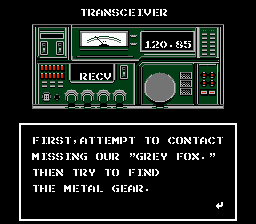
With a more limited colour palette, the people involved with porting it to the NES resorted to brighter colours, which killed the dark and gritty tone of the MSX2 version, and the whole opening segment was altered to include a jungle infiltration scene. In it, Snake parachutes into the jungle with two other soldiers; we don't know who they are, and we never find out either.
These opening segments totally killed the whole spirit of the original. The guard dogs were unavoidable, as were the soldiers in the next area. When you'd reached the perimeter of Outer Heaven, you had to board one of many trucks to take you to the right area, and it wasn’t clearly spelled out for you. Eventually, after a long winded and boring opening segment, which I imagine many players at the time (without the benefit of GameFAQs) gave up on, Snake arrives in Outer Heaven, and the game starts to keep to a relatively similar track as the MSX2 version.
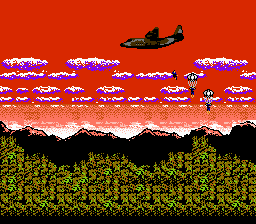
There were, however, a number of differences. Weapon range was far longer, and no rewards were given for playing stealthily. Also, after dying you’d respawn with all the items you were carrying when you died. All of this essentially turned the original, moody MSX2 classic into a trial and error isometric shoot ‘em up, totally losing what made the original special.
Bugs and oddities from the MSX2 version also found their way onto the NES too, such as abusing the transceiver to get unlimited items, punching through the wall in the prison to find Gray Fox and smoking to extend the time in the final battle. However, the NES version created a whole set of its own on top.
Unlike in the original, where guard placement was dictated by which door you entered from, the NES version only has one placement for each room, making some areas wholly un-sneakable in the back tracking segments; you’re spotted the second you enter them.
Ignoring all of that, it remains sort of faithful to the original MSX2 version, only having you stumble through unavoidable encounter to unavoidable encounter, following the plot of the original loosely through Outer Heaven. Some of the areas areas resemble original, while other parts are strangely different, until you reach Metal Ge– oh, wait, that's very different.
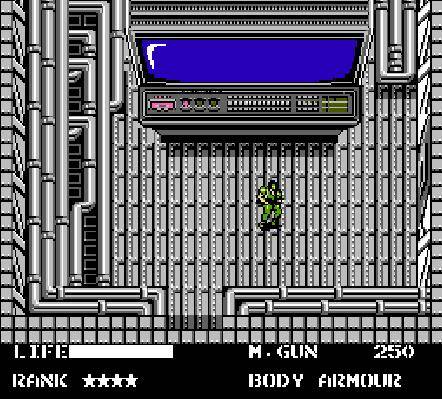
Metal Gear on the NES doesn’t actually have a Metal Gear. Instead, you have to sabotage a supercomputer — which is ostensibly a large monitor in a room protected by four guards — before going back on the original path and fighting Big Boss.
As a whole, despite all the differences that do the original a major disservice, Metal Gear on the NES does resemble the MSX2 version on the surface, and in the most superficial way possible. But the NES port suffers one more indignity which Kojima so obviously wanted to avoid in the original: its instruction booklet.
Back in the day, the people who wrote the instruction booklets were separate from the people who actually made the game. Often times, games didn’t come with anything remotely resembling a plot, so it was up to booklet writers to create a fictional grounding for the games. These writers often took liberties with the game's fiction. A lot of liberties. Metal Gear on the NES was no different.
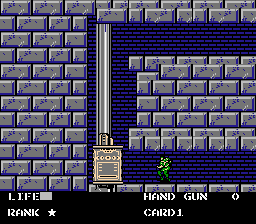
According to the manual, the leader of the terrorist organisation heading up Outer Heaven was a chap called Colonel Vermon CaTaffy (despite Big Boss clearly being the boss at the end), who was a crazed terrorist from a young age. Apparently he had 27 sisters who he grew up with in outer Mongolia, and led a terrorist organisation that pillaged the world before settling in South Africa to form Outer Heaven. His motivation? Not Big Boss' dream to create a world where soldiers were needed, but to cause as much misery to everyone else as possible. Metal Gear was the linchpin of this plan, and Solid Snake was sent to stop it at any cost.
Often times, a game’s instruction booklet wasn’t the story as intended by the game’s creators, but never have I seen a booklet more at odds with the game itself than Metal Gear’s. It was an abomination, moreso because the spirit of the original was kept perfectly in-tact for the Japanese release, and could’ve been so simply translated with none of this CaTaffy nonsense.
For many years, the NES port was the only way North American audiences could legitimately play Metal Gear, and because of that the game is common and widespread within NES circles and eBay sales. But since the original MSX2 version has been ported to the PlayStation 2, there’s really no excuse to play this disappointing port beyond morbid curiosity.
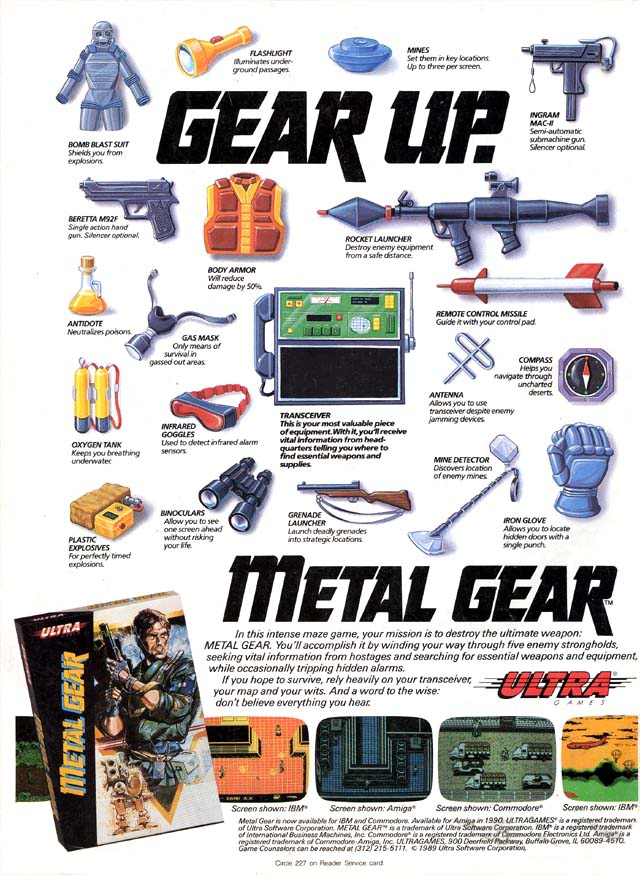
Unfortunately the curse of the NES version wasn’t the last of Metal Gear’s porting woes. Buoyed by its success in North America, in 1990 Ultra Games commissioned Commodore 64, MS-DOS and Amiga ports of Metal Gear for release in those system’s most popular territories.
And rather strangely, instead of opting to port the MSX2 version, which at that point had been translated into English for British audiences, they were instead instructed to port the shoddy NES version.
The result was an unmitigated disaster.
Metal Gear (C64)

Commodore 64 Version
The C64 version, ported by Unlimited Software Inc., is a version I’d neglected to play until recently. Back when I ran my MGS site, I passed reviewing duties on to one of our members, who returned with a depiction of the game which shocked even me, going as far as describing the audio as “a tape recording underwater of a dog trying to bark while choking on an entire chalk quarry shoved down its throat, and attempting to commit suicide via slamming its head against an exploding typewriter.”
Playing it myself, I can’t say it was quite that bad, but Unlimited Software did take liberties with its audio, putting a track that sounds more suited to a surfing game on the menu screen.
The audio is only the first, most apparent issue with the game. Pre-empting the Psycho Mantis controller switching trick from Metal Gear Solid, Unlimited Software had you use joystick port 1 to go from the title screen to the menu, and then joystick 2 to operate the menu, and back to joystick 1 to play the game. Thankfully, the C64 emulator I was using allowed me to map joystick 1 and 2 to the same keys, but until I’d realised that I had to make the switch (the game helpfully doesn’t tell you), I was mashing buttons on the menu to no avail, thinking it had locked the thing up.
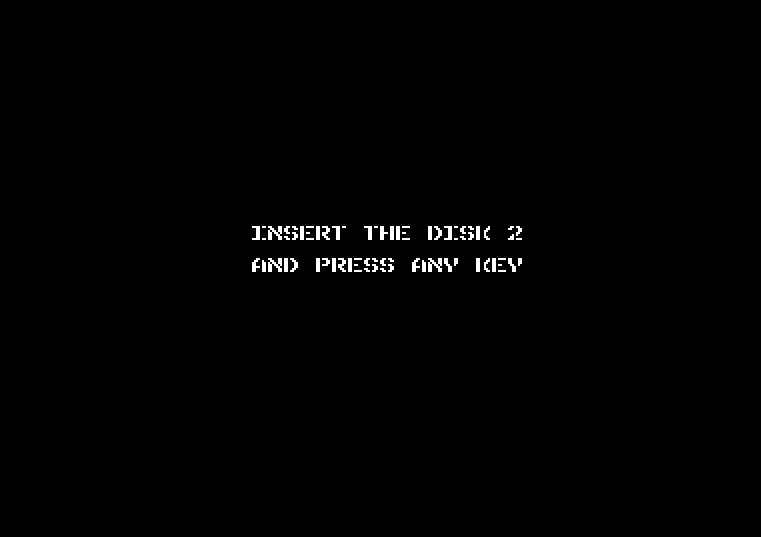
It only gets worse. The first thing the game asks you to do after starting a new game is switch disks, and after a ten second loading sequence, you start off where the NES version did. One notable thing they did fix was the three parachutes from the NES edition; the C64 port only has one.
But as the game took one step forward, it made a thousand back. The extremely limited processing power of the C64 meant I could briskly walk in front of guards, and it would take five to ten seconds for them to process my presence, again preempting a feature in future titles: the stealth device. I could effectively walk through areas without being spotted, despite moving through a foe’s field of vision.
As an experiment I waited in front of a guard until I was caught, which triggered the alert status. Though this status is effectively the same as not being in alert: no new guards attacked me, and the music didn’t change to the racy alert status tunes that Metal Gear is known for. No, all I had to do was punch my foe to death and everything was back to normal.
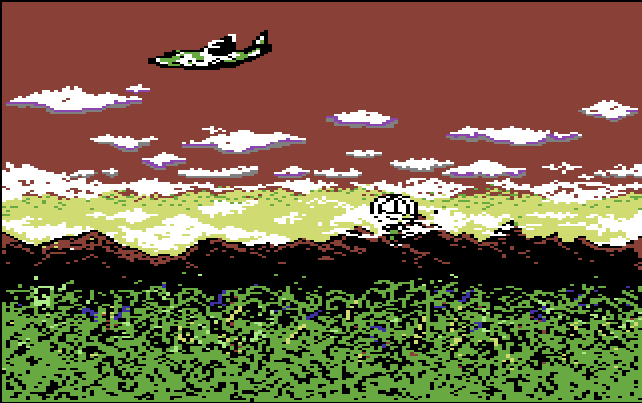
Besides the shoddy workmanship of this port, the game compounded the glitches of the NES version tenfold. Proceeding through door frames involved Snake walking above them, and item sprites were simply a horrible mess of jagged lines that were supposed to represent pistols, rations and so on. The entryway of one of the vans required to proceed to the next are was, in fact, placed inside a bush, instead of at the rear of the vehicle.
Besides all of this, areas were missing to accommodate the limited storage available on the game’s three disks, and the whole thing felt like an abridged version of the NES game.
I had attempted to play the Commodore 64 version from start to finish, but after leaving a room where one of the required key cards was placed, I spawned in the previous area on top of some crates, rendering me stuck in the environment. Not wanting to go through all of that again, and having a rather clear picture of the quality of the C64 version, I left the future horrors which it may contain, and moved on to the next version: MS-DOS.
Metal Gear (MS-DOS)

MS-DOS Version
The MS-DOS version was ported by someone called Charles Ernst, and from what I’ve played, it appears to be the zombie apocalypse version of Metal Gear.
For starters, enemies can’t shoot. When you’re spotted, they act in an erratic fashion, as if they’re high on speed, and then they sort of run into you and drain your health at an extraordinary rate. Within a second of touching an enemy, you die, and instead of the typical spinning until death animation on every other version, the MS-DOS port has you turning into a skeleton, as if they’d stripped the flesh from your bones.
This extreme difficulty makes getting past the first area a challenge in itself, as the guard dogs tear you limb from limb. It took me no less than thirty attempts before I’d worked out a route through, and after I’d passed the dogs, I was met with some more zombie guards who also seemed to like the taste of my flesh.
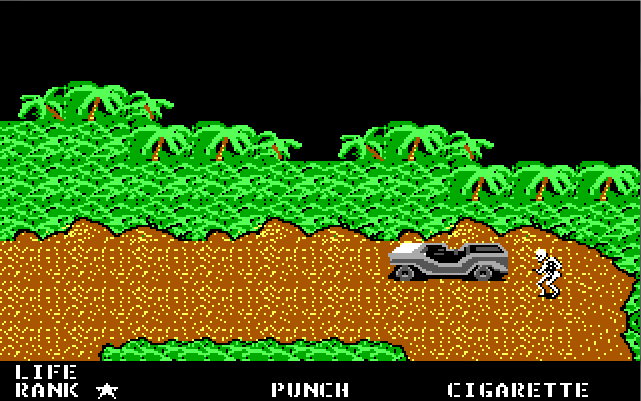
With no way to save, Metal Gear for MS-DOS played like trying to dig through a concrete wall with a box of plastic spoons. After enduring the zombie guards and working out a route into the base, I died after Snake’s head overlapped a trap door, and I decided that development of this game had barely started, let alone finished. Understandable, considering only one man handled it, but inexcusable since Konami felt it fit for release, unlike the Amiga version which, thankfully, never saw the light of day.
As with the NES version, these ports of Metal Gear should only be played as a masochistic curiosity, rather than as a viable way to experience the first entry in the long running Metal Gear Saga. I can’t stress this enough: play the MSX2 version.
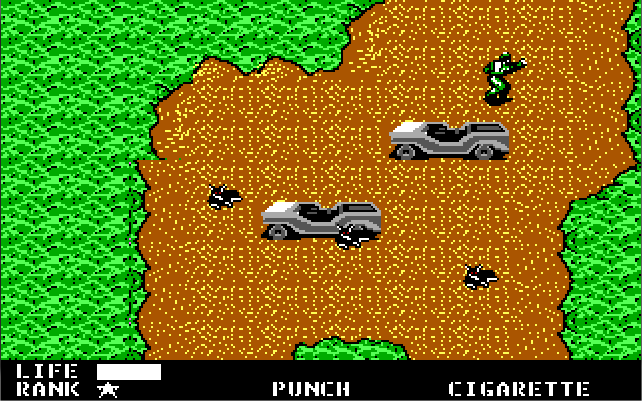
And that’s it: nearly 4,000 words later, and I've only just got around to wrapping up Metal Gear. With it’s rather basic plot and presentation it really isn’t the best game to have a deep fan analysis and criticism of. However the variety of ports it spawned is fascinating for anyone with even a shred of interest in how a game designed for the vastly superior MSX2 made its way onto the inferior NES, and then the even more inferior C64, enduring a shoddy MS-DOS port along the way.
And if you ever wanted a reason as to why Hideo Kojima was so reluctant to have his future Metal Gear Solid games ported to other platforms, you only need look at the poor job done with Metal Gear to see why.
Coming next time…
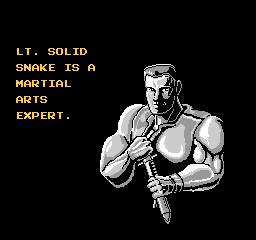
Part 3: Snake's Revenge on the NES
Further Reading
Metal Gear at The Snake Soup — Probably the best MGS fansite currently out there.
Metal Gear [C64] Review by Crushed at archive.org — This is an archived version of my old MGS site, specifically the Metal Gear C64 review I quoted.
You can reach Chris' homepage at Been There, Played That or get in touch with him on Twitter.
